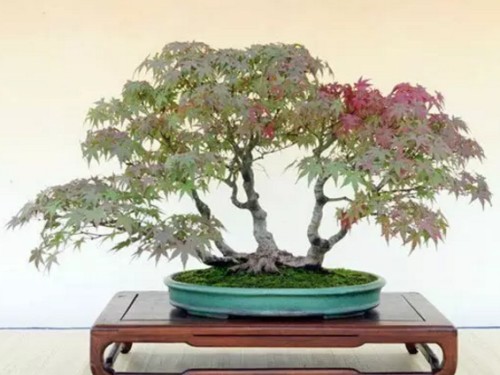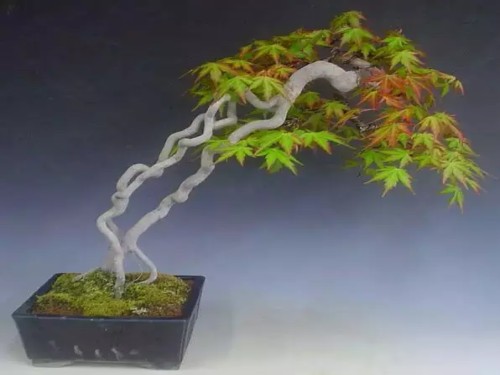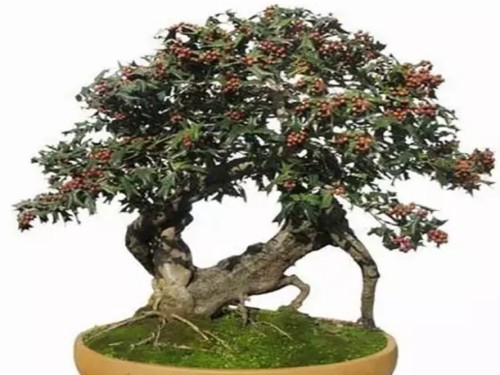Making method of Maple Bonsai
There are many maples in the wild, and bonsai is often made to dig up old stakes or young trees in the mountains. The new maple branches are long and soft and can be tied into various styles of bonsai. The common ones are direct dry type, oblique dry type, curved dry type, double dry type and water-facing type. Maple trees are mainly shaped by scissors and supplemented by pruning. Maple leaves are larger and are not easy to be made into cloud flakes or clouds, so the branches and leaves are often trimmed into a natural style of coordination and density.
Maple trees have strong germination and often grow new buds on the trunk. Buds and over-dense branches that are not needed in modeling should be cut off in time, which not only saves nutrition, but also helps ventilation and light transmission. The best viewing period for maple trees is when new leaves are just released. When all the leaves are removed at the end of summer and once ripened and rarefied liquid fertilizer is applied, the new leaves grow out in about 20 days, which can increase the best viewing period.

For maple bonsai production, in addition to processing methods, it is more important to choose the shape of the tree, and to make natural bonsai according to the original shape, and it takes a certain amount of time to shape. Each pot of maple bonsai should have its own characteristics. This article mainly talks about the maple bonsai production process.
1. Tree making
There are many maple trees in the wild, and bonsai is often made to dig old stakes or young trees in the mountains. The new branches of maple trees are long and soft, and can be tied into a variety of bonsai styles, such as straight dry type, oblique dry type, curved dry type, double dry type, water-facing type and jungle type. Maple tree shape is mainly pruned, supplemented by Panzha. Maple leaves are larger and should not be made into clouds or clouds, but branches and leaves are often trimmed into a natural style with high and low coordination and proper density. After frost, the maple leaves turn red, dazzling and lovable.
2. Planting and using pots
Maple trees should be planted from February to March before sprouting in spring. Before planting, you should trim the branches and roots, remove half of the old soil, replace it with new soil, and put rotten bean cake at the bottom of the bowl as base fertilizer. Maple trees like loose, fertile and moist soil and grow poorly in barren land. Maple trees can be planted with humus soil of 2DB 3 and sandy soil of 1pm 3 and used. The leaves of most maples change from green to red after frost in late autumn, so be careful not to use red and green purple sand pots or glazed pottery pots. Jungle type maple bonsai, can use white marble or marble shallow basin, the basin soil into a rugged natural mountain shape, if the appropriate part of the basin put a few pieces of tortoise stone or Yingde stone, dotted with a few characters or animals small furnishings, it will make the bonsai life flavor thicker.
Time: 2019-05-26 Click:
- Prev

How to lift the root of bonsai
The root is an important part of the stump bonsai. The distribution and shape of the root directly affect the ornamental value of the bonsai. Through planned cultivation, the roots of the stump are turned over, changed soil and changed pots year by year. In this process, the roots are arranged, the extension direction of the roots is mastered, and then they continue to be planted, gradually revealing the soil surface of the roots.
- Next

The method of making bonsai with Chinese wolfberry
The branches of Chinese wolfberry are dense, the leaves are peculiar, and the red fruits are bright in autumn. it is an excellent tree species for viewing leaves and fruits. Old pile bonsai posture is quaint, evergreen all the year round, suitable for viewing all the year round. Decorative applications can be cultivated as hedges in the courtyard, or potted, displayed in the hall and placed on several shelves, so as not to be touched by children because of thorns, so as to avoid injury.
Related
- Fuxing push coffee new agricultural production and marketing class: lack of small-scale processing plants
- Jujube rice field leisure farm deep ploughing Yilan for five years to create a space for organic food and play
- Nongyu Farm-A trial of organic papaya for brave women with advanced technology
- Four points for attention in the prevention and control of diseases and insect pests of edible fungi
- How to add nutrient solution to Edible Fungi
- Is there any good way to control edible fungus mites?
- Open Inoculation Technology of Edible Fungi
- Is there any clever way to use fertilizer for edible fungus in winter?
- What agents are used to kill the pathogens of edible fungi in the mushroom shed?
- Rapid drying of Edible Fungi

